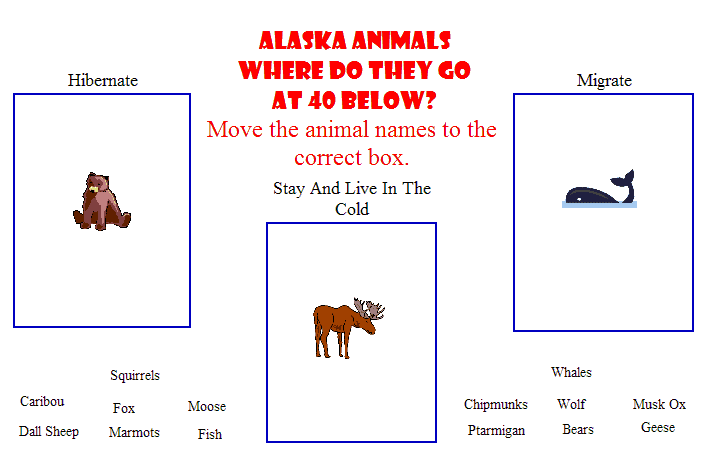We read Alaska Animals – Where Do They Go At
40 Below? by Bernd and Susan Richter. Mrs. Dennison met the
authors while in Alaska and it also coordinates with our current
animal unit. After reading it together, everyone created their
own Kidspiration file to divide the Alaska animals into groups:
migrate, stay, and hibernate. Then we read on the Internet about
animals that live in the Texas desert regions. We compared cold
climate and hot climate adaptations.
Texas Animals – Where Do They
Go At 120 Above?
http://www.nps.gov/amis/epaclp.htm
Alaska Animals
– Where Do They Go At 40 Below?
By Bernd and Susan Richter
Some animals in west Texas live in the desert.
They have some very difficult conditions to deal with - not much
water and high temperatures. Some desert animals can actually go
through life without ever taking a drink of water. Desert
animals have some very important adaptations that enable
them to live in the desert.
Alaska is known as the land of
snow, ice, and long, cold winters. At such extreme temperatures,
exposed skin, especially on ears, noses, and fingers, can freeze
within minutes. Alaska’s wild animals don’t have heated houses.
They also have important adaptations that enable them to survive
the cold temperatures.
Food – Water From Food -
Some desert animals, such as pack rats can get all of the water
that they need by eating juicy cactuses and other plants that
have lots of water in them. Some snakes can get all of the
moisture that they need from the mice and other small animals
that they eat.
Food - Change of Diet –
Some animals like the moose simply change
what they eat. In the winter they eat twigs of bushes and bark
of trees that aren’t covered by the snow. In the summer they eat
fresh leaves
Move to Water - Large desert animals, such as mountain lions
or deer, can get some of the water that they need from the food
they eat. In order to get all of their needed water, these
animals must also drink water, too. To find sources of water,
these larger desert animals may have to travel great distances.
Migrate to Warmer
Climate – Canada geese in Alaska may fly up to 5,000 miles
south. Most whales swim far away from Alaska to the south where
waters are much warmer. Before the water freezes fish swim away
from the shallow creeks and rivers to deep river sections that
don’t freeze all the way to the bottom. Some actually swim all
the way to the ocean.
Estivate - Some desert animals deal with the hot, dry times
(droughts) by "sleeping" through it. They estivate through the
dry periods. Spadefoot toads can wait out dry periods
underground for months and even years. They are covered with a
jellylike substance that keeps them moist while they are waiting
for rain. Some desert rodents, snails and spiders "sleep"
through the hottest, driest times of the year. By estivating,
animals can avoid not only hot, dry conditions but also a food
shortage.
Hibernate – Before the winter arrives, bears find a cave
called a den. Bears eat a lot in the summer and then hibernate
or sleep through the winter. Other animals that hibernate are
marmots, arctic ground squirrels, and chipmunks.
Staying Out Of The Sun - Many desert animals avoid the
daytime heat by being nocturnal (active at night). Some animals
are active only during the early morning and late afternoon
(cooler times of the day). During the heat of the day, when
ground temperatures can reach 160 F., lizards, snakes, insects
and other animals will get out of the heat - digging into the
ground, going into other holes, crawling under rocks, looking
for shade under bushes and trees, etc. Some birds, such as
vultures, will fly higher into the sky, where temperatures are
cooler.
Camouflage – The ptarmigan, the Alaska state bird, turns
white with the exception of its beak and eyes, which keeps it
safe from predators. With the protection of two layers of
feathers it is able to keep out the wind and water to help it
survive the cold weather. Other animals that change their color
to white are the snowshoe hare, the arctic fox, and the weasel.
Big ears and long legs - Big ears help to cool down their
owners by radiating heat out of the animal's body. Like big
ears, long legs also radiate body heat. And, long legs keep
vital internal organs away from the hot ground. Some insects and
lizards keep their insides cooler by straightening out their
legs as they walk across the hot ground. Thick Fur and Long Legs
– Moose spend winters in pretty much the same areas that they
spend their summers.
Their thick fur keeps them nice and warm and their long legs
allow them to walk through the snow. Caribou have a thick fur
coat and for food walk to areas where the snow cover in
thinnest. These are usually treeless and high-lying areas where
strong winds blow fresh snow away. The caribou use their strong
hooves to paw the snow away to get to edible plants.
Click
here to learn more about Alaska.
Click
on Image to View Full Size

Download
Kidspiration Activity File

